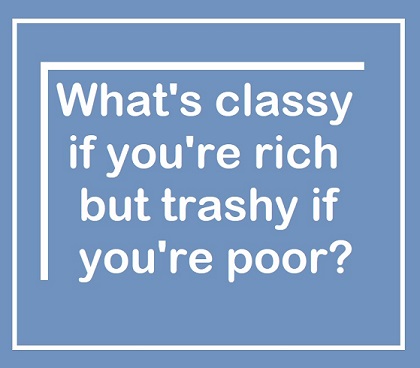
Classy or Trashy – A Bilingual Dilemma
If you haven’t spend time on TikTok then you are probably well-adjusted and have dedicated phone curfews for yourself. I applaud you. For the rest of us, you know TikTok offers some awesome prompts for people to stitch that are sometimes both too real and hilarious. I may try my hand at one later, but for now I felt like typing out some thoughts on one I originally saw as a meme, then video: “What’s classy if you’re rich but trashy if you’re poor.”
My answer: Being bilingual.
I took my child to the neighborhood playground yesterday for some fresh air, knowing the place to normally be abandoned, thus meeting my safety parameters as well. I saw a young boy and girl, perhaps around nine years old, on the bigger kid sets and overheard them chatting. Such a sweet conversation among siblings that also happened to be in French. (I dabble). They yelled to their mother who was on the tennis court. They talked about what they wanted for dinner, and told each other to be careful. Well, more specifically, the girl told her brother to be careful as he took every pole and arch as his own personal gymnastic practice. Impressive but potentially painful. As they chatted intermittently my husband and I recalled an old conversation.
We are raising our child to be bilingual. My entire family and I speak to her in Spanish, even my husband reinforces frequent words and phrases. It was many years ago, but we were watching those awful racist incidents caught on camera where bitter old bitties would randomly tell people to “speak English” or “Go back to where you came from,” upon hearing them speak another language. I don’t know about you but we noticed a pattern regarding the targets of such despicable and absurd admonishments; at least the ones that went viral enough to reach various streams of news. You guessed it… Spanish speakers.
While we would all love to forget the chaos and vitriol overload that took over the past four years, that same vitriol is what emboldened closet racists to reveal themselves, giving us these phone captured memories of shame. I know tensions are high right now between this subgroup of people and the Spanish speaking community over publicly stoked fears and misinformation, but even before then, running into a parent speaking to their child in another language in public always elicited some sort of reaction from people, though rarely a verbal attack.
We wondered, what it was about a Spanish speaking child that didn’t seem to invoke the same level of “impressive” as a child speaking French, German, or even Russian? What is it about Spanish speaking children that evokes judgment over one speaking Mandarin or Portuguese? When do you suppose the bias began?
Perhaps I’m really getting older because I recall a time when speaking Spanish was still considered “exotic.” I was thriving during the “Latin Boom” of the 2000’s when several popular Latinx artists were “crossing over” into mainstream American pop charts. Don’t act like Ricky Martin wasn’t a phenomenon all on his own. Though many Latinx were listening to him since he was a kid, no American raised millennial or older reading this can deny they were “livin la vida loca” for almost half a decade. Don’t lie to yourself. I see you.
Consider these statistics from Children’s Defense Fund,
More than 10 million children—nearly 1 in 7 (14.4 percent)—lived in poverty in 2019, the most recent year for which U.S. Census Poverty Data are available.
Historical, systemic racism and institutional barriers mean that children of color have been particularly vulnerable to child poverty. Black and Hispanic children experience some of the highest poverty rates in the country, and 71 percent of children in poverty in 2019 were children of color.
Nearly 1 in 5 children of color in America (20.5 percent) were poor. Children of color were 2.5 times more likely to be poor than their white, non-Hispanic peers.
More than 1 in 4 Black children (26.5 percent) and 1 in 5 Hispanic children (20.8 percent) and American Indian/Alaska Native children (20.6 percent) were poor, compared with 1 in 12 white, non-Hispanic children (8.3 percent) and 1 in 14 Asian, Native Hawaiian, and other Pacific Islander children (7.7 percent) (see Tables 4-5).4
The Children’s Defense Fund is a 501(c)(3) nonprofit organization. Federal Tax ID number is 52-0895622.
Perhaps then, the bias stems from a capitalistic disdain for the poor and not the Spanish speaking community at large, because our subconscious has connected people of color with their likelihood to be poor per our society’s design. Therefore, it’s easier to blame racism, an obvious evil, than acknowledge an even deeper rooted aporophobia.

The Unicorn Dilema
Baby Banana Pancakes
You May Also Like

Top Three Thursday – Un-American?
October 27, 2016
Monday Musing – Spice of Life
July 2, 2018